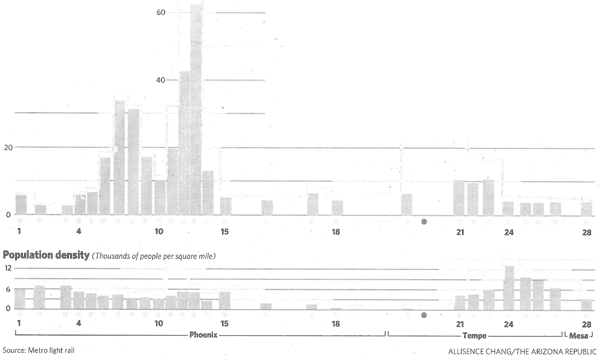Grass Roots Efforts to Impose Socialism
At first, I thought this was an interesting article in the battle of urban planners against suburban "sprawl." Here is the voice of the often silent majority, who like suburbs and don't want a bunch of high-density mini-Manhattans :
Jones and his neighbors moved to Laveen's low-scale subdivisions in
hopes of finding a suburban life near the heart of the Valley, where
they could enjoy large, affordable homes a few miles southwest of
downtown Phoenix."We had the opportunity to buy a brand-new home we could afford, and
we had a view of downtown," Pacey says. "The potential to make this as
wonderful as other areas of Phoenix is huge."
The story has the typical highly-connected former politician turned developer (is there another kind?) using his unique access to his old zoning cronies to manipulate regulation for personal profit:
Then Paul Johnson, a former Phoenix mayor, proposed taking a mostly
vacant 27-acre parcel a few blocks east of Jones' home and building 517
apartments and townhouses on it.The property was zoned for one house to the acre. It abuts a
two-lane road where the speed limit, when two nearby schools are in
session, is 15 mph. And the nearby intersection of 27th and Southern
avenues, which provides access to downtown Phoenix, is still controlled
by stop signs.Schools in the neighborhood already were overcrowded, and residents
were concerned about the police's ability to keep up with calls for
service. Where were all these new people going to go?"They've done so much building in Laveen that the infrastructure has
not kept up," says Jones, an auditor who had no previous involvement in
civic affairs.Despite a resident outcry and opposition from Michael Nowakowski,
the councilman who had just been elected to represent the district, the
council approved the rezoning 7-1 on Dec. 19.
Johnson gets extra bonus points as the urban-chic villain, expressing the superiority of sitting in cafes to, say, having a back yard.
As a former mayor, Paul Johnson is familiar with residents' arguments against high-density developments.
"They feel that any time you have additional density, that it means
a lower quality," he says one morning over coffee at Biltmore Fashion
Park. "The counter to that is this."Johnson gestures across Camelback Road to the high-rise apartments and townhomes near 24th Street.
"I look out across the street, and there's a lot of density there,"
he says. "But I'm also sitting in a pretty nice cafe. I have a nice
place to sit. And there's a lot of other people here who think it's a
nice place."
But it turns out that there are no good guys in this story, as is often the case for your poor libertarian correspondent. Because, the opponents of such development are turning to the ballot box, converting property decisions from individual ones made by the property owner to group decisions made on election day. What can be built on this particular property may well be decided at the ballot box, just as I discussed another parcel of land whose fate will be decided not by its owner, but at town elections in November.
Sometimes, the reaction to government control is a bid for de-regulation. But more often, it merely results in a scrap for power, as parties ignore the question of whether the government power should exist at all, and instead fight over who gets to wield it.
For the most part, it has been up to city councils to decide how
much density one neighborhood can tolerate. If Jones is successful,
they could lose some of that power."It speaks to the age-old dilemma of representative democracy versus
direct democracy," said Paul Lewis, an assistant professor of political
science at ASU. "There's always an issue with land use because what
might be in the overall interest of the city might still be seen as a
detriment to its immediate neighborhood."
This is all very depressing. No mention of any age-old question between individual rights and government power. For these guys, the "city" and the "neighborhood" are somehow real entities with more rights than actual people.
For centuries we have had a perfectly serviceable approach for determining who gets to decide what gets built on a piece of land: ownership. If one wanted to control a property, she/he bought it. But the desire to control property without really owning it is a strong one, and a driving force for much of government regulation.



